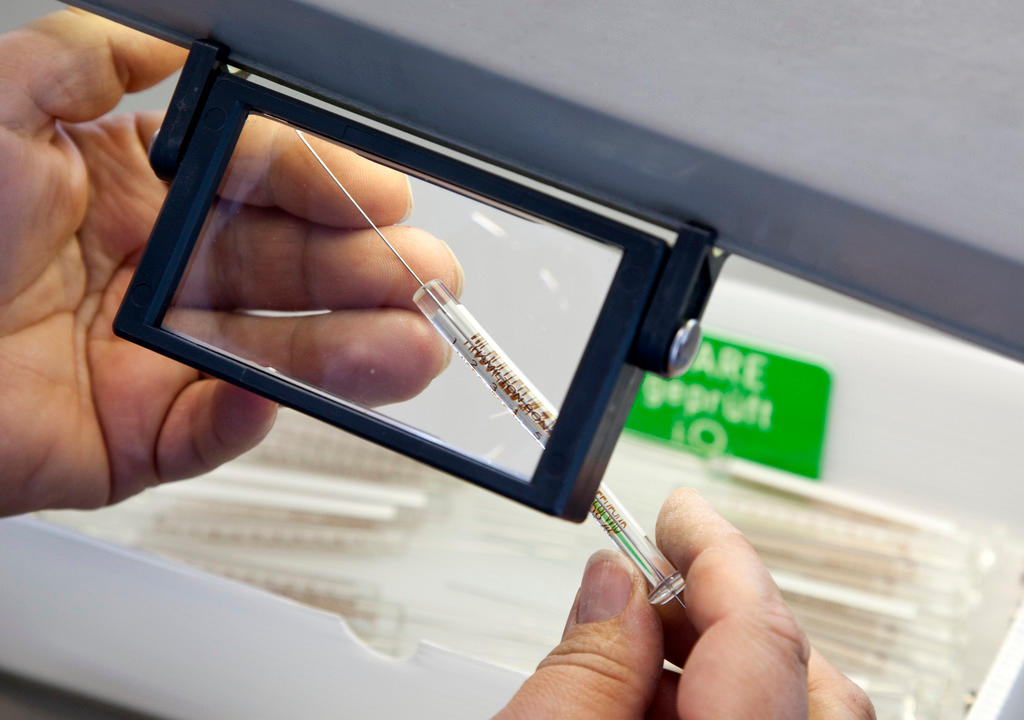Pharma turns to big data to gauge care and pricing

Big pharma companies are turning to big data in an attempt to keep up with shifts in market demand. Swiss-based Novartis is no different.
After many years building successful technology businesses, Jeremy Sohn never imagined that at 43 he would find himself on the payroll of a big pharmaceutical company.

More
Financial Times
External linkBut 18 months ago he was appointed global head of digital business development and licensing at Swiss drugmaker Novartis. His appointment is evidence of how an industry, slow to respond to the disruption of digitisation, is grasping its importance as it confronts pricing pressures, ever-vaster quantities of patient data and more empowered consumers.
Digitisation is changing the way pharma interacts with payers, doctors and patients, leading drugmakers to seek out different skills and personality traits in employees.

More
Novartis: The making of a pharma giant
Germany’s Merck last year appointed 30-year-old James Kugler as its first chief digital officer, with a degree in biomedical engineering and a tech background. Boehringer Ingelheim, Europe’s biggest private drugmaker, hired Simone Menne as chief financial officer from airline Lufthansa. She is in charge of a new digital “lab”, recruiting data specialists and software developers.
Mr Sohn, whose role at Novartis includes overseeing venture capital investments in technology companies – a growing trend in Big Pharma – says that working alongside highly qualified scientists, he “typically feels like the dumbest person in any meeting”. However, he and other external recruits have brought mindsets that are helping the group evolve from a pure science company into “a data [and] technology company”, he adds.
According to Steven Baert, head of human resources, Novartis is starting to reap considerable benefits from digital investments, particularly in the speed and efficiency with which it can test medicines.
He says: “We’re already seeing how real-time data capture can help analyse patient populations and demographics, to make it easier to recruit patients for clinical trials, and how real-time data-capture devices, like connected sensors and patient engagement apps, are helping to create remote clinical trials that aren’t site-dependent.”
Sweeping changes
In the past five years, these changes have been visible in Novartis’s workforce. While staffing overall has risen by just over 20 per cent, the salesforce – the traditional bedrock of pharma companies, and their combined $1tn in global revenues – has increased by just 13 per cent.
At the same time the number employed in “market access” – negotiating prices with payers, whether governments or insurers – has risen up to five times faster than the average growth rate and now stands at 1,100.

More
Export growth increasingly depends on pharmaceuticals
Novartis employs more than 1,200 dual-qualified mathematicians and engineers to analyse big data sets and calculate the value of new drugs – for instance, their potential to reduce hospitalisations and so cut costs. As recently as six years ago, not a single one was on the payroll.
Behind these changes lie two key shifts. The first is the determination of cash-constrained global health systems to secure better value from the drugs they buy.
The second is the advance of digital technology, which is increasingly playing a role in how patients manage their conditions and companies communicate the benefits of their medicines to doctors. GlaxoSmithKline, for example, employs more than 50 people to run webinars with physicians – a “multichannel media team” that did not exist five years ago.
The UK drugmaker has begun hiring astrophysicists to work in research and development, keen to deploy their ability to visualise huge data sets. The company says these qualities are especially important as it seeks to use artificial intelligence to help spot patterns and connections amid a mass of information.
At Boehringer, senior executives say that this level of disruption calls for agility and entrepreneurialism in employees – which in some cases may be better found outside the life sciences sector.
Andreas Neumann, head of HR, explains that, although new CFO Ms Menne had “no clue” about pharma, she had worked in a sector that had faced substantial upheaval.
“She has significant experience in an industry which is under tremendous cost pressure and has gone through a tremendous amount of change. And you can learn from that experience, as a company.”
Data mining
US-based Pfizer last year recognised this new landscape by establishing a division to bring together health economists; researchers measuring the outcomes produced by different medicines; and market access specialists. Previously these groups had been spread throughout the organisation.
Andy Schmeltz, who heads the division, gives the example of Eliquis, an anticoagulant produced with Bristol-Myers Squibb. Data analysts processed “real world” evidence – derived from patients going about their normal lives, rather than taking part in a carefully managed trial – that suggested it was more cost effective than the long-established anticoagulant, Warfarin.
Underpinning this work is a massive repository of data, from sources such as electronic medical records, that covers “over 300m lives”, says Mr Schmeltz.
This, he says, “enables us to query the database and generate insights, even when we’re just trying to figure out the design of a trial and the feasibility of recruitment; are there enough patients out there that meet certain entry criteria? It enables us to make better decisions on clinical trial development. It also enables us to model different outcomes across different diseases.”
At Merck, chief executive Stefan Oschmann enthuses about its new breed of digitally savvy employee, led by “forward-thinking” Mr Kugler. “We’re working on stuff like the connected lab,” he says, “a laboratory where everything, every container, every machine, every pipette, is smart and connected and captures data automatically… So we [employ] a very different type of people these days.”
While the project is still in the planning stages, when complete it will allow staff to manage inventory and research across multiple labs and share findings more readily, as well as making it easier to access safety and regulatory compliance data.
The road ahead
The pharma industry still has a considerable way to go before it exploits digital technology as successfully and automatically as many other sectors. A recent report by McKinsey, the global consultancy, assessed “digital maturity” under a range of categories including strategy and customer focus. Only the public sector, an infamous digital laggard, came out worse.
Stefan Biesdorf, who leads McKinsey’s digital pharma and medical technology work in Europe, says: “While virtually every pharma company has either worked on its digital strategy or made plans about how to address the topic, compared with other industries pharma… still has a lot to do.”
One analyst describes some big pharma companies as “schizophrenic” about how to respond to digital advances, aware they needed to act but unsure how much investment to divert from their core mission of drug discovery.
Alyse Forcellina, leader of the Americas healthcare practice at executive recruitment consultancy Egon Zehnder, says Big Pharma needs outsiders because “nobody in pharma is excellent at digital”.
She warns, however, of the risk of “organ rejection” of new recruits who, for instance, may not understand that “many things are illegal or just not possible” in pharma, such as direct approaches to patients.
Mr Baert of Novartis acknowledges there is also a danger that companies will hire the right people but fail to foster the internal culture required to take advantage of their expertise.
However, he cites as a warning the example of Kodak, which was at the forefront of discovering digital technology but failed to accelerate the shift to a new business model.
At Boehringer, Mr Neumann acknowledges the process is not always smooth. But he is in no doubt about the potential gains if companies can create an environment in which diversity of background is seen as an advantage, not a threat.
He says: “If you hire someone who is disruptive because you want disruption, you get what you have hired, right?”

In compliance with the JTI standards
More: SWI swissinfo.ch certified by the Journalism Trust Initiative




You can find an overview of ongoing debates with our journalists here. Please join us!
If you want to start a conversation about a topic raised in this article or want to report factual errors, email us at english@swissinfo.ch.